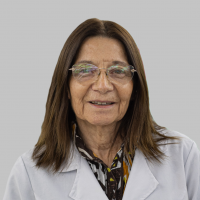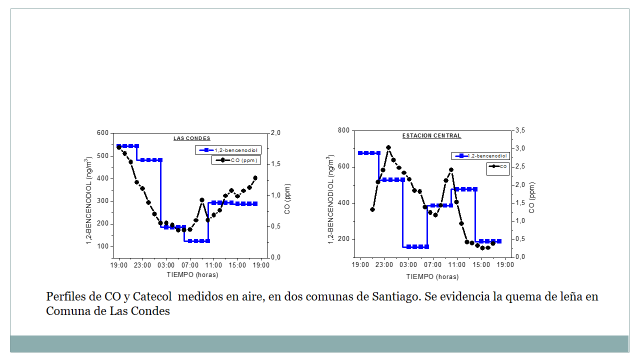You are here
Dr. María Rubio

She has conducted research projects on environmental Chemistry topics: Atmospheric Chemistry and Chemistry of aquatic systems. Main results are related to evaluate oxidizing capacity Santiago atmosphere and the determination nitrated phenols in gas phase and in atmospheric particulate matter. The main results on the subject of water pollution are related to design, manufacture, etc. Nano materials capable for removing heavy metals and metalloids from aqueous matrices from diverse origin. The application in removal and its chemical stability to environmental factors are studied.
Tracers in the air of chilean cities: sources, transformations and removal. FONDECYT 2017 2017-2019 Responsible researcher.
For excellence technology and reinvestigation centers. Center for the development of nanoscience and nanotechnologies PROJECT BASAL CONICYT 2019. 2019-2023 researcher Optimization and application filter material of diverse origin FONDEF Project 2017 2018-2019 Principal Researcher
"STUDY OF THE VERTICAL BLACK CARBON AND TEMPERATURE PROFILE IN SANTIAGO AND ITS RELATIONSHIP TO POLLUTION NEAR THE SURFACE FONDECYT 2015. 2015-2017 Co-RESEARCHER
CHEMICAL COMPOSITION OF DEW WATERS AND ITS TEMPORARY EVOLUTION IN URBAN AREA OF SANTIAGO DICYT USACH 2020 2020-2022 Principal Researcher
Publications 2020
- Efficient and selective removal of SeVI and AsV mixed contaminants from aqueous media by montmorillonite-nanoscale zero valent iron nanocomposite. JonathanSuazo-Hernández* Karen Manquián-Cerda María de la Luz Mora MauricioMolina-Roco MaríaAngélica Rubio fBinoySarkar NanthiBolan NicolásArancibia-Miranda Journal of Hazardous Materials Volume 403, 5 February 2021, 123639 https://doi.org/10.1016/j.jhazmat.2020.123639 9,038
- Relationship between UV Energy and Formation of Secondary Particles in Santiago de Chile. Ernesto V. Gramsch*, Cristian R. Soto, Pedro P. Oyola, Felipe A. Reyes, Yeanice Vasquez, María A. Rubio, Patricio A. Pérez, and Matías Tagle. .Aerosol Air Qual. Res. https://doi.org/10.4209/aaqr.2018.08.0318 2,74
- Black carbon transport between Santiago de Chile and glaciers in the Andes Mountains. Ernesto Gramsch*, Alicia Muñoz, Joakim Langner, Luis Morales, María A. Rubio. Atmos environ Volume 232, 1 July 2020 . https://doi.org/10.1016/j.atmosenv.2020.117546 4,039
- Nafcillin degradation by heterogeneous electro-Fenton process using Fe, Cu and Fe/Cu nanoparticles. Sebastian Campos, Ricardo Salazar, Nicolás Arancibia-Miranda, M.A. Rubio, Mario Aranda, Alejandra García, Pamela Sepúlveda, L.Carolina Espinoza Chemosphere 247:125813 · January 2020. DOI: 10.1016/j.chemosphere.2020.125813 5,1
- Atmospheric phenolic derivatives as tracers in an urban area
María a. Rubio1, Patricia Bustamante, Yeanice Vásquez J. Chil. Chem. Soc., 64, N°2 (2019)
http://dx.doi.org/10.4067/S0717-97072019000204407 0,4
- Photooxidation of Emissions from Firewood and Pellet Combustion Using a Photochemical Chamber.
Felipe Reyes, Yeanice Vasquez , Ernesto Gramsch , Pedro Oyola , Bernhard Rappenglück and María A. Rubio*
Atmosphere 2019, 10, 575; doi:10.3390/atmos10100575 2,39
- Synthesis and characterization of zeolite-based composites functionalizedwith nanoscale zero-valent iron for removing arsenic in the presence of selenium from water, Jonathan Suazo-Hernándeza,b,⁎, Pamela Sepúlvedac,d, Karen Manquián-Cerdad, Rodrigo Ramírez-Taglee, María Angélica Rubio, Nanthi Bolanf, Binoy Sarkarg,⁎, Nicolás Arancibia-Miranda.
Journal of Hazardous Materials 373 (2019) 810–819. https://doi.org/10.1016/j.jhazmat.2019.03.125 9.038
- As(V) removal capacity of Fe-Cu bimetallic nanoparticles in aqueous solutions: The influence of Cu content and morphologic changes in bimetallic nanoparticles Pamela Sepúlveda , María A. Rubio , Samuel E. Baltazar , J. Rojas-Nunez , J.L. Sánchez Llamazares ,Alejandra García Garcia , Nicolás Arancibia-Miranda* J. Of Colloid and interface Science. 2018 vol.524, 15, 177-187. 4,23
- Partitioning of the water soluble versus insoluble fraction of trace elements in the city of Santiago, Chile María A. Rubio*, Karen Sánchez, Pablo Richter, Jorge Pey, Ernesto Gramsch. Atmosfera 31(4) 373-387. 2018. Doi: 10.20937/ATM.2018.31.0405 1.083
- Preparation of nanoscale iron (oxide, oxyhydroxides and zero-valent) particles derived from blueberries: Reactivity, characterization and removal mechanism of arsenate. Mankian K. Cruces Edgardo; María A Rubio; Camila Reyes; Nicolás Arancibia-Miranda. Ecotoxicology and Environmental Safety 2017, 145:69-77 doi 10.1016/j.ecoenv.2017.07.004. 3.74 3.74
- Modeling study of biomass burning plumes and their impact on urban air quality; a case study of Santiago de Chile.G. C. Cuchiara,* B. Rappenglück, M.A. Rubio , E. Lissi, E. Gramsch, R.D. Garreaud. Atmospheric environmental. 2017, 166, 79-91. doI 1352-2310 3.78 3,78
- Kinetics of the anaerobic reaction of para-substituted Phenols with nitrogen dioxide. Jael Reyes, Eduardo Lissi, Camilo Lopez-Alarcón, María A. Rubio*, International Journal of Chemical Kinetics, 2017,1, vol 49, 28-36 doi: 0538-8066 1.52
Publications 2016
- Retention of Atmospheric Particulate by Three Woody Ornamental Species in Santiago, Chile. Nicole Guerrero-Leiva Sergio A. Castro, María A. Rubio Claudia Ortiz-Calderón. Water Air Soil Pollut. 2016, 227:435, doi. 0049-6979 1,76
- Prevalence of freshly created particles during pollution episodes in Santiago de Chile. E. Gramsch, F. Reyes, Y. Vásquez ,P. Oyola, M. A. Rubio, R. Labbé. Aerosol and Air Quality Research, 16, 2172-2185. 2016 DOI: 1680-8584 2,58
- Comparative study of two analytical methods to the determination of boron in leachate samples from sanitary landfills and groundwater routine analysis and feasible on-site environmental monitoring. Palma P., Calderon R., Godoy M., Rubio M.A. International Journal of Environmental Analytical Chemistry. 2016. DOI10.1080/03067319.2016. 1,37
- Nanoscale Zero Valent Supported by Zeolite and Montmorillonite: Template effect of the removal of lead ion from an aqueous solution. N.Arancibia-Miranda, S.E.Baltazar, A.García, D.Muñoz-Lira, P.Sepúlveda, M.A.Rubio, D.Altbir. . Journal of Hazardous Materials 301: 371–38, 2016. HAZMAT-D-14-06074R2. 9,038

